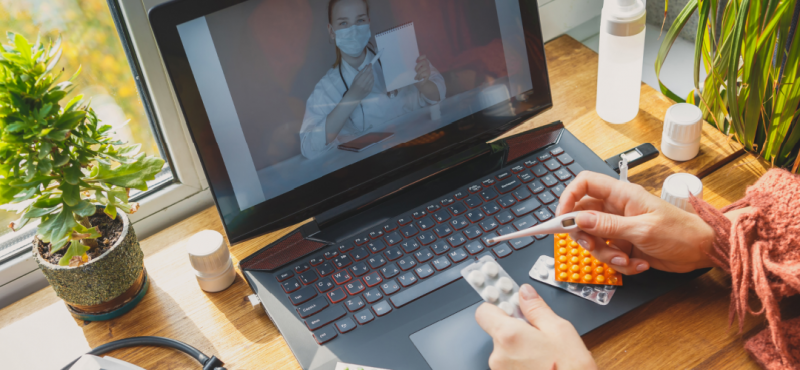Did you or someone in your household “skip” a doctor’s appointment in 2020? Or maybe you put off the dentist again, because of the pandemic…Or your local clinic was only seeing COVID-19 patients? Well, if you answered “yes” to any those questions, you wouldn’t be alone. In fact, nearly 1 in 5 U.S. households reported that at least one member was unable to get care or was forced to delay care for a serious condition.
And while we all turned to Zoom for work, school and socialization, telehealth solutions also picked up steam — and not just for the healthcare industry, but for technologists, innovators and broadband providers alike.
“The COVID-19 pandemic created the pressure to further digitize our [healthcare] systems,” said Dr. Vivian Lee, vice president of platforms for Verily during a panel at the 2021 Consumer Electronics Show (CES), where telehealth was a hot topic of conversation. “It’s advantageous to everyone to move to digital health and get access to care when and where you need it.”
Nope, This Isn’t Sci-Fi
Imagine a home internet network that powers hundreds of connected devices, including telehealth devices that can do everything from taking your temperature and blood pressure, to monitoring your everyday health for red flags that indicate more serious issues. Those devices are also seamlessly and immediately communicating to your doctor so they can deliver a holistic home healthcare solution.
We’re not far off from this reality. Today’s home broadband networks are already able to power a growing number of connected devices and, with COVID-19, the power of these networks is accelerating quickly (we’ll go into more detail in a minute.) In fact, Dr. Lee and her fellow panelists are already seeing tech improving patients’ health and creating better outcomes when telehealth solutions can capitalize on the right three conditions:
- high-speed broadband networks
- low-latency capability
- cutting-edge technology.
The Beyond community is encouraged to see much of this ideal mixture already coming together. We’re tracking one critical piece of the puzzle now and into the future: high-speed internet.
A Foundation of High-Speed Internet
U.S. broadband providers are hard at work building and maintaining the reliable, high-speed networks that power telehealth technologies. In fact, U.S. broadband networks already deliver speeds of 1 gigabit per second to over 80% of homes across the country. These speeds enable connected telehealth devices to pass data and information back to healthcare providers remotely, then quickly allow providers to analyze that data and make diagnoses. Isn’t that something?!
The same internet providers who deliver 1 gig speeds are simultaneously working to make those network 10x faster, with enhanced capacity, reliability, security, and the super-low latency needed to run hundreds of emerging telehealth devices.
And while some of the most emerging technologies are being tested in Mediacom’s 10G SmartHome in Ames, Iowa, including telehealth solutions from UnityPoint Health, others are already on the market and available to consumers. Here are two that the Beyond community is most excited about:
1. Trapollo’s “Hospital as a Home” Experience
With Trapollo’s “hospital as a home” solution, you can receive medical care from a hospital by utilizing an app on your smartphone or tablet. Once you download the app, it enables you to be fully monitored by a healthcare provider, to receive important medical advice or information, and to participate in two-way video communication. This is above and beyond Zoom doctor’s visits. This is the full spectrum of at home care.
“Now with smart homes being a part of the healthcare environment, the concept of creating the ‘Smart Healthy Home,’ as I like to call them, is here.” said Mike Braham, Trapollo’s chief executive officer. “There is a great amount of flexibility in what we can do both as a patient and as a caregiver.”
2. Kinsa’s Network of Smart Thermometers
The telehealth tech geniuses at Kinsa have developed an early warning system to detect and respond to contagious illness – tech that’s become super important in light of the COVID-19 pandemic. Kinsa utilizes a network of millions of smart thermometers to track the spread of illness in real-time and forecast future outbreaks.
The company has already had success predicting flu incidents months out – and is even good at doing it on a city-by-city basis. With the right combination of broadband infrastructure, telehealth technology, and connected devices, Kinsa CEO and Co-Founder, Dr. Inder Singh, believes that the technology could have the power to predict – and prevent – the next pandemic.
“The power of the networks is amazing,” said Kinsa’s Dr. Singh, “If we can get communication with someone at the earliest sign or symptom, or when they first got sick, we could also see whether or when symptoms are starting and how fast they are spreading.”
Telehealth solutions hold an incredible amount of potential to improve our lives, and not only because of our current pandemic situation. For now, we ask that you join our call to expand rural broadband access to American’s living in remote areas can take advantage of this technology. In the meantime, our community will continue pushing for a policy environment that allows all innovators, big and small, to have the freedom build the next great telehealth idea and transform our world for the better.
